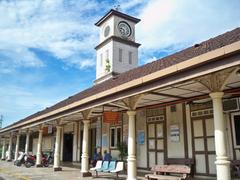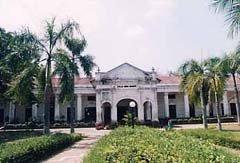Comprehensive Guide to Visiting Paddy Museum, Alor Setar, Malaysia
Date: 16/08/2024
Introduction
Nestled in the heart of Alor Setar, Malaysia, the Paddy Museum, also known as Muzium Padi, offers an immersive journey into the rich agricultural heritage of the region. Officially inaugurated on October 12, 2004, by Kedah Sultan Abdul Halim Muadzam Shah, it stands as a tribute to the history, culture, and economic significance of paddy farming in Kedah (Wikipedia). Often referred to as the ‘Rice Bowl’ of Malaysia, Kedah plays a crucial role in the country’s rice production, making the museum a vital educational and cultural institution. The museum’s unique architecture, inspired by bushels of harvested rice stalks, and its extensive exhibitions provide a comprehensive understanding of the paddy cultivation process and its importance to Malaysian society (Malaysia Tourist Spot). This guide aims to provide all the information you need for a memorable visit, including the museum’s history, visitor information, and what makes it a must-see attraction in Alor Setar.
Table of Contents
- Introduction
- History and Significance
- Cultural and Economic Importance
- Exhibitions and Displays
- Educational Value
- Visitor Experience
- Nearby Attractions
- FAQ
- Conclusion
History and Significance
Historical Background
The Paddy Museum, located in Alor Setar, Kota Setar, Kedah, Malaysia, was constructed on land owned by the Malaysian Agricultural Development Authority at a cost of MYR 24.7 million. It was officially inaugurated and opened on October 12, 2004, by Kedah Sultan Abdul Halim Muadzam Shah (Wikipedia).
Architectural Significance
The museum’s architecture is a significant aspect of its identity. The building is a three-story structure with a total area of 12,000 square meters. Inspired by bushels of harvested rice stalks, it features rice motifs throughout, including on the gates, fences, and staircase banisters (Malaysia Tourist Spot). Murals by 60 North Korean artists, created after extensive research, adorn the walls (The Island Drum).
Cultural and Economic Importance
Kedah is known as the “Rice Bowl” of Malaysia due to its significant contribution to the country’s rice production. The Paddy Museum serves as a tribute to the history, culture, and importance of paddy farming in Kedah. It is the first paddy museum in Malaysia and the fourth in the world, following similar institutions in Japan, Germany, and the Philippines (Malaysia Tourist Spot).
Exhibitions and Displays
Permanent Exhibitions
The Paddy Cultivation Process
One of the most captivating permanent exhibitions at the Paddy Museum is the detailed portrayal of the paddy cultivation process. This exhibit meticulously outlines each stage of rice farming, from land preparation and planting to harvesting and processing. Visitors can observe traditional tools and techniques used by Malaysian farmers, providing a comprehensive understanding of the agricultural practices that have sustained the region for centuries. Interactive displays and multimedia presentations enhance the learning experience, making it accessible and engaging for all ages.
Diorama of Paddy Fields
A highlight of the museum is the expansive diorama that vividly depicts the lush paddy fields of Kedah. This three-dimensional model spans an entire room and offers a panoramic view of the rural landscape, complete with miniature farmers, water buffaloes, and traditional Malay houses. The diorama is accompanied by detailed explanations of the various elements, allowing visitors to appreciate the intricate balance of nature and human effort required in paddy farming.
Temporary Exhibitions
Seasonal Farming Techniques
The museum frequently hosts temporary exhibitions that focus on specific aspects of paddy farming. One such exhibition is dedicated to seasonal farming techniques, showcasing how farmers adapt their methods to the changing weather patterns throughout the year. This exhibit includes rare photographs, historical documents, and interviews with local farmers, providing a rich tapestry of information that highlights the resilience and ingenuity of the farming community.
Innovations in Rice Cultivation
Another notable temporary exhibition explores the innovations in rice cultivation. This exhibit features the latest advancements in agricultural technology, including genetically modified rice strains, modern irrigation systems, and sustainable farming practices. Interactive kiosks allow visitors to explore these innovations in depth, offering a glimpse into the future of rice farming and its potential impact on food security and environmental sustainability.
Special Galleries
Cultural Significance of Rice
The Cultural Significance of Rice gallery delves into the profound impact of rice on Malaysian culture and society. This gallery showcases traditional artifacts, such as ceremonial tools, clothing, and musical instruments, that highlight the role of rice in various cultural practices and rituals. Visitors can also learn about the symbolic meanings of rice in local folklore and religious ceremonies, gaining a deeper appreciation for its cultural importance.
Art and Rice
The Art and Rice gallery is a unique space that celebrates the artistic expressions inspired by rice and paddy fields. This gallery features a diverse collection of paintings, sculptures, and installations created by local and international artists. The artworks reflect the beauty and significance of rice in everyday life, offering a creative perspective on this staple crop. Special exhibitions within this gallery often include live art demonstrations and workshops, allowing visitors to engage with the artists and their creative processes.
Educational Value
The museum is an excellent educational resource, especially for students. It contains historical artifacts related to rice cultivation from various Asian countries. The exhibitions are designed to be informative and engaging, making it an ideal destination for school field trips (Trip.com).
Visitor Experience
Best Times to Visit and Travel Tips
The best time to visit is during the dry season, typically from March to September. Public transportation or taxis are convenient ways to get there. The museum is wheelchair accessible, and guided tours are available upon request.
Opening Hours and Tickets
The museum is open daily from 9:00 AM to 5:00 PM. Tickets are priced at RM 5 for adults and RM 2 for children aged 7-12. Group discounts are available for school trips and large tours (The Island Drum).
Accessibility
The museum is designed to be accessible to all visitors, with ramps and elevators available for those with mobility issues. Audio guides and printed materials are also available in multiple languages, ensuring that non-Malay speakers can fully enjoy the exhibits.
Souvenirs and Dining
The museum shop offers a range of souvenirs, including locally produced rice, traditional crafts, and books on paddy farming. There is also a café on-site that serves a variety of rice-based dishes, allowing visitors to taste the local cuisine and further connect with the cultural significance of rice.
Nearby Attractions
While visiting the Paddy Museum, take the opportunity to explore other historical sites in Alor Setar, such as the Alor Setar Tower and the Zahir Mosque. The Alor Setar Tower is a 165.5-meter telecommunication tower that offers restaurants, a souvenir shop, and an observatory (Travalour). The Zahir Mosque, located 9 km from the museum, is one of the grandest and oldest mosques in Malaysia, voted one of the top 10 most beautiful mosques in the world (Travalour).
FAQ
What are the Paddy Museum’s visiting hours?
The museum is open from 9:00 AM to 5:00 PM, Monday to Sunday.
How much are tickets to the Paddy Museum?
The entry fee is RM 5 for adults and RM 2 for children aged 7-12. Group discounts are available.
How do I get to the Paddy Museum?
Public transportation and taxis are readily available. The museum is accessible by car and offers parking facilities.
Conclusion
The Paddy Museum in Alor Setar is more than just a museum; it is a celebration of the rich cultural heritage and economic significance of paddy farming in Kedah. Its unique architecture, extensive exhibitions, and educational value make it a must-visit destination for anyone interested in rice cultivation in Malaysia. Whether you are a student, a history buff, or a casual visitor, the Paddy Museum offers a memorable and enriching experience. Visit, explore, and immerse yourself in the fascinating world of paddy farming.
Stay updated on the latest events and exhibits at the Paddy Museum by following us on social media. Download our mobile app Audiala for more information and related content about historical sites in Malaysia.
References
- Wikipedia, 2023, Paddy Museum
- Malaysia Tourist Spot, 2023, Paddy Museum Kedah
- The Island Drum, 2023, Kedah Paddy Museum
- Trip.com, 2023, Paddy Museum
- Travalour, 2023, Kedah Paddy Museum



